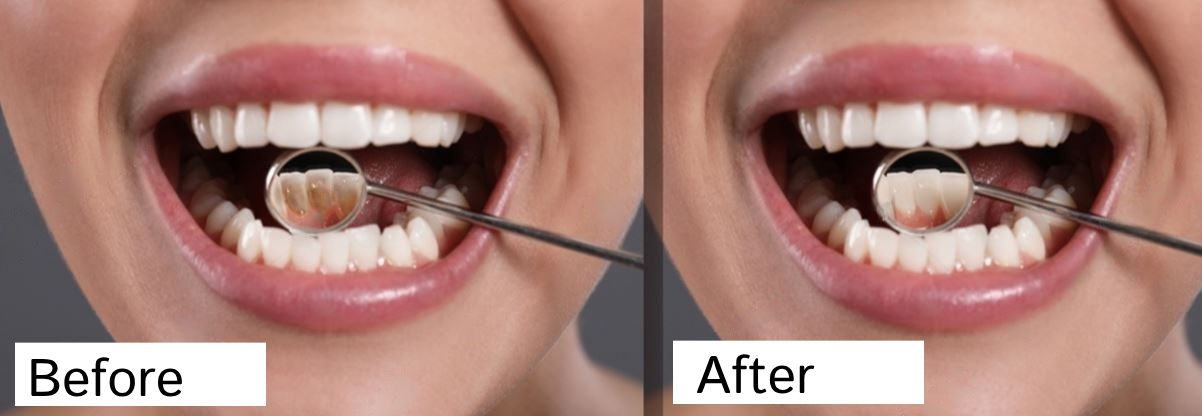Health
HOW PLAQUE CAN BECOME A CALCULUS BRIDGE

Plaque, a sticky film of bacteria, constantly forms on our teeth. When not properly removed, it can transform into a hardened substance known as calculus, or tartar, leading to various oral health issues. Understanding how plaque evolves into calculus is crucial for maintaining optimal oral hygiene and overall health.
Introduction to Plaque and CALCULUS BRIDGE
Plaque is a biofilm containing bacteria that forms on teeth surfaces. It develops within hours after brushing and can lead to tooth decay and gum disease if not removed regularly. Calculus, on the other hand, is hardened plaque that firmly adheres to teeth and cannot be removed by brushing alone. This accumulation serves as a breeding ground for more bacteria, exacerbating oral health problems.
Formation of Plaque
Plaque formation begins with the colonization of bacteria in the mouth. These bacteria feed on sugars and carbohydrates from food, producing acids that attack tooth enamel. Without proper oral hygiene, plaque continues to accumulate, creating a breeding ground for more bacteria.
Consequences of Untreated Plaque
Failure to remove plaque through brushing and flossing can result in gingivitis, an early stage of gum disease characterized by inflammation and bleeding gums. If left untreated, gingivitis can progress to periodontitis, a more severe form of gum disease that can lead to tooth loss.
Transformation into Calculus
Over time, plaque mineralizes and hardens into calculus due to the deposition of minerals from saliva. Once calculus forms, it cannot be removed by brushing alone and requires professional dental intervention.
Risk Factors for Plaque to Calculus Transition
Several factors increase the risk of plaque transforming into calculus, including genetics, diet high in sugars and carbohydrates, smoking, and certain medications that reduce saliva flow.
Prevention Techniques
Preventing plaque buildup is key to avoiding calculus formation. This includes maintaining a regular oral hygiene routine of brushing twice a day, flossing daily, using mouthwash, and consuming a balanced diet low in sugary and starchy foods.
Professional Removal Methods
Dental professionals use scaling and root planing techniques to remove calculus from teeth surfaces. Regular dental cleanings are essential for maintaining oral health and preventing the progression of gum disease.
Home Remedies for Plaque and Calculus Control
While not as effective as professional cleanings, some home remedies may help control plaque and calculus buildup. These include oil pulling, brushing with baking soda, and rinsing with diluted apple cider vinegar.
Impact of Calculus on Oral Health
Calculus buildup can lead to gum recession, tooth sensitivity, and chronic bad breath. It creates an ideal environment for bacteria to thrive, contributing to oral health problems.
Relationship Between Plaque, Calculus, and Systemic Health
Research suggests a link between oral health and systemic conditions such as heart disease, diabetes, and respiratory infections. Managing plaque and calculus is not only essential for oral health but also for overall well-being.
The Importance of Early Detection and Treatment
Regular dental visits allow for early detection of plaque and calculus buildup. Dentists can identify signs of developing calculus and provide timely intervention to prevent further oral health complications.
Maintaining Oral Health Post-Treatment
Following professional cleanings, maintaining good oral hygiene practices is crucial for preventing plaque and calculus recurrence. This includes brushing and flossing regularly, as well as making dietary adjustments to reduce sugar intake.
Common Misconceptions About Plaque and Calculus
Contrary to popular belief, brushing harder does not remove calculus and may damage tooth enamel. Additionally, invisible plaque can still harm teeth and gums, highlighting the importance of thorough oral hygiene practices.
The Role of Dental Professionals
Dental professionals play a critical role in educating patients about plaque and calculus prevention. They develop individualized treatment plans based on each patient’s unique needs and ensure patient compliance for optimal oral health outcomes.
Conclusion
Plaque serves as the precursor to calculus, a hardened form that poses significant risks to oral health. Understanding the process of plaque transformation and implementing effective prevention and treatment strategies are essential for maintaining optimal oral hygiene and overall well-being.
Unique FAQs
- Can plaque and calculus lead to tooth decay? Yes, both plaque and calculus contribute to tooth decay by harboring bacteria that produce acids, which erode tooth enamel.
- Are home remedies for plaque and calculus removal effective? While some home remedies may offer temporary relief, they are not as effective as professional dental cleanings for removing calculus.
- Can calculus be prevented entirely through oral hygiene practices? While proper oral hygiene can significantly reduce calculus buildup, professional dental cleanings are necessary for complete removal.
- Is calculus removal painful? Dental professionals use techniques to minimize discomfort during calculus removal procedures, ensuring a relatively pain-free experience.
- How often should I visit the dentist for professional cleanings? It is recommended to visit the dentist for regular cleanings every six months to maintain optimal oral health.
Health
Revitalizing Health with Wellhealthorganic.com:Buffalo Milk

In the quest for optimal health and wellness, the choices we make regarding our diet play a pivotal role. Among the myriad options available, buffalo milk stands out as a nutritious and wholesome choice, offering a range of benefits that contribute to overall well-being. At wellhealthorganic.com, the focus on quality and sustainability ensures that every sip of buffalo milk is not just a refreshment but a step towards revitalizing health.
The Nutritional Powerhouse of Buffalo Milk
Buffalo milk is renowned for its rich nutritional profile, making it a valuable addition to any diet. Here are some key nutrients found in buffalo milk:
- Protein: Buffalo milk contains a higher protein content compared to cow’s milk, making it an excellent choice for those looking to boost their protein intake.
- Calcium: It is a significant source of calcium, vital for maintaining strong bones and teeth.
- Vitamins: Buffalo milk is rich in essential vitamins such as vitamin A, D, and B-complex vitamins, which support various bodily functions.
- Minerals: It is also packed with minerals like phosphorus, magnesium, and potassium, essential for overall health and well-being.
Health Benefits of Consuming Buffalo Milk
- Bone Health: The calcium and phosphorus content in buffalo milk contribute to maintaining healthy bones and preventing conditions like osteoporosis.
- Muscle Growth and Repair: The high protein content supports muscle growth, repair, and recovery, making it an ideal choice for athletes and fitness enthusiasts.
- Heart Health: Studies suggest that buffalo milk’s composition may help in lowering cholesterol levels, thereby promoting heart health.
- Digestive Health: The presence of probiotics and beneficial enzymes in buffalo milk can aid digestion and promote a healthy gut microbiome.
Sustainability and Ethical Practices at wellhealthorganic.com
Apart from its nutritional superiority, buffalo milk from wellhealthorganic.com is sourced through sustainable and ethical practices. The commitment to organic farming ensures that the milk is free from harmful chemicals, antibiotics, and synthetic hormones. This not only benefits the consumers but also supports environmental conservation and animal welfare.
Incorporating Buffalo Milk into Your Diet
There are numerous ways to enjoy the goodness of buffalo milk in your daily diet:
- As a Beverage: Enjoy a glass of refreshing buffalo milk on its own or use it as a base for smoothies and shakes.
- In Cooking: Use buffalo milk to prepare creamy sauces, desserts, and baked goods for a rich and flavorful touch.
- With Cereals and Grains: Pour buffalo milk over cereals, oats, or porridge for a nutritious breakfast option.
Conclusion
In conclusion, buffalo milk from wellhealthorganic.com is not just a beverage but a symbol of health, sustainability, and ethical practices. Its nutritional richness, coupled with the commitment to quality, makes it a standout choice for individuals looking to enhance their well-being through mindful dietary choices. Embrace the goodness of buffalo milk and embark on a journey towards holistic health and vitality.
FAQs:
- Is buffalo milk suitable for lactose-intolerant individuals?
- While buffalo milk contains lactose, some lactose-intolerant individuals find it easier to digest compared to cow’s milk. It’s best to consult a healthcare professional for personalized advice.
- Can buffalo milk be used for making cheese and yogurt?
- Yes, buffalo milk is commonly used for making various dairy products such as cheese, yogurt, and butter due to its rich and creamy texture.
- Is buffalo milk suitable for children?
- Buffalo milk can be a nutritious option for children, providing essential nutrients for growth and development. However, moderation is key, especially for young children.
- How does buffalo milk compare to cow’s milk in terms of taste?
- Buffalo milk has a richer and creamier taste compared to cow’s milk, making it a preferred choice for those who enjoy a fuller flavor profile.
- Is buffalo milk environmentally friendly?
- Yes, buffalo milk production is often considered more environmentally friendly than cow’s milk production, as buffaloes are more efficient in converting feed into milk and require less water and land resources.
Health
Ayurvedic Health Tips for Well-Being

Ayurveda, the ancient system of medicine originating in India, offers a holistic approach to health and well-being. In today’s fast-paced world, where stress and lifestyle-related diseases are on the rise, incorporating Ayurvedic principles into our lives can lead to profound improvements in overall health. Let’s delve into some Ayurvedic health tips for a well-balanced life.
1. Introduction to Ayurveda
Ayurveda, often referred to as the “science of life,” dates back thousands of years and is based on the belief that health and wellness depend on a delicate balance between the mind, body, and spirit. Its fundamental principles revolve around the concept of achieving harmony with nature and understanding individual constitution.
2. Understanding Well-Being in Ayurveda
In Ayurveda, well-being is viewed holistically, encompassing physical, mental, and spiritual aspects. Central to this philosophy are the three doshas: Vata (air and space), Pitta (fire and water), and Kapha (earth and water). Each person has a unique combination of these doshas, which influences their physical and psychological characteristics.
3. Ayurvedic Lifestyle Tips
Ayurveda emphasizes the importance of daily and seasonal routines (Dinacharya and Ritucharya) to maintain balance and harmony with nature. This includes practices such as waking up early, practicing yoga and meditation, and eating meals at regular intervals.
4. Dietary Guidelines
Diet plays a crucial role in Ayurveda, as it is believed to be the foundation of good health. Ayurvedic dietary guidelines recommend consuming fresh, seasonal foods that are suited to one’s dosha constitution. For example, individuals with a Pitta imbalance should favor cooling foods, while those with a Vata imbalance may benefit from warm, nourishing meals.
5. Herbal Remedies and Supplements
Ayurveda harnesses the healing power of herbs and natural supplements to promote overall health and well-being. Common herbs such as turmeric, ashwagandha, and triphala are known for their antioxidant and immune-boosting properties.
6. Yoga and Exercise Recommendations
Yoga, an integral part of Ayurveda, offers a multitude of benefits for both physical and mental health. Practicing yoga asanas tailored to one’s dosha type can help balance the body and mind, improve flexibility, and reduce stress.
7. Stress Management Techniques
In Ayurveda, stress is viewed as a significant contributor to disease. Meditation, mindfulness practices, and the use of adaptogenic herbs such as holy basil and brahmi can help alleviate stress and promote emotional well-being.
8. Promoting Digestive Health
According to Ayurveda, a healthy digestive system is the cornerstone of good health. Incorporating dietary habits such as eating mindfully, favoring warm, cooked foods, and avoiding incompatible food combinations can support optimal digestion.
9. Quality Sleep Practices
Adequate and restful sleep is essential for maintaining balance in Ayurveda. Establishing a relaxing bedtime routine, creating a conducive sleep environment, and avoiding stimulating activities before bed can help promote quality sleep.
10. Detoxification and Cleansing
Ayurveda advocates periodic detoxification and cleansing to rid the body of accumulated toxins (ama) and restore balance. Practices such as fasting, herbal cleanses, and Panchakarma therapies can rejuvenate the body and mind.
11. Natural Skincare and Beauty Tips
Ayurveda offers natural and holistic approaches to skincare, emphasizing the use of herbs, oils, and seasonal rituals to enhance beauty from within. Incorporating practices such as oil massage (abhyanga) and herbal facials can nourish the skin and promote a youthful glow.
12. Managing Chronic Health Conditions
Ayurveda provides personalized treatments for a wide range of chronic health conditions, including digestive disorders, arthritis, and stress-related ailments. Integrating Ayurvedic therapies with conventional medicine can offer comprehensive and holistic care.
13. Preventive Healthcare
Preventive healthcare is a cornerstone of Ayurveda, focusing on maintaining balance and preventing disease before it manifests. By incorporating Ayurvedic practices into daily life, individuals can proactively promote long-term health and wellness.
14. Seeking Professional Guidance
While Ayurveda offers valuable insights into health and well-being, it’s essential to consult with a qualified Ayurvedic practitioner for personalized guidance. A trained practitioner can assess one’s unique constitution and recommend tailored lifestyle modifications and herbal remedies.
15. Conclusion
Incorporating Ayurvedic health tips into your daily routine can pave the way for a healthier, more balanced life. By nurturing harmony between mind, body, and spirit and embracing the wisdom of Ayurveda, you can embark on a journey towards optimal well-being.
FAQs
- Is Ayurveda safe for everyone?
- How long does it take to see results with Ayurvedic practices?
- Can Ayurveda treat chronic health conditions?
- Are Ayurvedic supplements regulated?
- How do I find a qualified Ayurvedic practitioner?
Health
WELLHEALTH HOW TO BUILD MUSCLE TAG: A GUIDE TO A HEALTHIER YOU

Introduction to Building Muscle
In today’s wellness-conscious society, the pursuit of a healthier lifestyle often involves building muscle. Beyond the aesthetic appeal of a toned physique, strong muscles contribute significantly to overall health and vitality. However, embarking on a muscle-building journey requires more than just lifting weights; it entails a holistic approach that encompasses nutrition, exercise, and rest.
Understanding the Importance of Muscle Health
Muscles are not just for bodybuilders or athletes; they play a crucial role in everyday activities, from lifting groceries to climbing stairs. Maintaining adequate muscle mass is essential for preserving mobility, preventing injury, and supporting metabolic function.
Benefits of Building Muscle
Building muscle offers a myriad of benefits beyond aesthetics. It increases metabolism, aiding in weight management and fat loss. Additionally, strong muscles enhance bone density, reducing the risk of osteoporosis, and improve insulin sensitivity, lowering the chances of developing type 2 diabetes.
Setting Goals for Muscle Building
Before embarking on a muscle-building journey, it’s essential to set clear and achievable goals. Whether aiming for increased strength, muscle definition, or overall fitness, defining objectives provides direction and motivation.
Defining Realistic and Achievable Goals
Set specific, measurable, attainable, relevant, and time-bound (SMART) goals to ensure success. Consider factors such as current fitness level, lifestyle constraints, and personal preferences when establishing targets.
Importance of Setting a Timeline
Having a timeline creates a sense of urgency and accountability, preventing procrastination and ensuring consistent progress. Break long-term goals into smaller milestones to track achievements effectively.
Nutrition for Muscle Growth
Nutrition plays a pivotal role in muscle development, providing the building blocks necessary for repair and growth. A well-balanced diet rich in protein, carbohydrates, healthy fats, vitamins, and minerals is essential for optimizing muscle-building potential.
Protein-Rich Diet
Protein is the cornerstone of muscle growth, as it provides the amino acids needed for muscle repair and synthesis. Incorporate lean sources of protein such as chicken, fish, tofu, beans, and legumes into your meals to support muscle recovery and growth.
Essential Nutrients for Muscle Development
In addition to protein, ensure adequate intake of carbohydrates for energy, healthy fats for hormone production, and micronutrients such as vitamins and minerals for overall health and performance.
Effective Workout Routines
A well-designed workout routine is crucial for stimulating muscle growth and strength gains. Focus on compound exercises that target multiple muscle groups simultaneously, incorporating both resistance training and cardiovascular activities for optimal results.
Resistance Training
Include exercises such as squats, deadlifts, bench presses, and rows to build strength and muscle mass effectively. Gradually increase the intensity and volume of your workouts to challenge your muscles and promote growth.
Incorporating Cardio for Overall Health
While resistance training is paramount for muscle building, don’t neglect cardiovascular exercise for cardiovascular health and calorie expenditure. Aim for a balance between strength training and cardio to achieve a well-rounded fitness regimen.
Recovery and Rest
Rest and recovery are often overlooked but are critical components of the muscle-building process. Allow your muscles adequate time to recover between workouts to prevent overtraining and maximize gains.
Importance of Rest Days
Schedule regular rest days to allow your muscles to repair and rebuild stronger. Listen to your body and prioritize sleep, as adequate rest is essential for muscle recovery and overall well-being.
Muscle Recovery Techniques
Incorporate strategies such as foam rolling, stretching, massage, and contrast baths to enhance recovery and alleviate muscle soreness. Listen to your body’s cues and adjust your training intensity and frequency accordingly.
Avoiding Common Mistakes
In the pursuit of building muscle, it’s essential to avoid common pitfalls that can hinder progress and increase the risk of injury.
Overtraining
While consistency is key, overtraining can lead to burnout, fatigue, and injury. Allow for adequate rest and recovery between workouts, and pay attention to signs of fatigue or stagnation.
Poor Form During Workouts
Maintain proper form and technique during exercises to prevent injury and ensure optimal muscle engagement. Seek guidance from a qualified fitness professional if unsure about proper exercise execution.
Tracking Progress
Tracking progress is essential for staying motivated and assessing the effectiveness of your training program. Keep a detailed workout journal and utilize technology such as fitness apps and wearable devices to monitor metrics such as strength, endurance, and body composition.
Keeping a Workout Journal
Record your workouts, including exercises, sets, reps, and weights lifted, to track progress over time. Reviewing your training history can help identify patterns, set new goals, and celebrate achievements.
Utilizing Technology for Tracking
Take advantage of fitness apps, wearable devices, and online platforms to monitor various aspects of your fitness journey, from nutrition and workouts to sleep and recovery. Set reminders, track trends, and analyze data to optimize your training and lifestyle habits.
Staying Motivated
Maintaining motivation is essential for long-term success in building muscle. Find sources of inspiration, celebrate small victories, and cultivate a positive mindset to overcome challenges and stay committed to your goals.
Finding Inspiration
Surround yourself with supportive peers, mentors, or role models who inspire and motivate you to strive for excellence. Visualize your goals, create a vision board, or seek out success stories to stay inspired and focused on your journey.
Celebrating Small Victories
Acknowledge and celebrate progress, no matter how small, to reinforce positive habits and maintain momentum. Set mini-goals and reward yourself for achieving milestones, whether it’s a new personal record, improved physique, or consistent adherence to your routine.
Conclusion
Building muscle is a rewarding endeavor that requires dedication, consistency, and a comprehensive approach to nutrition, exercise, and recovery. By setting realistic goals, prioritizing proper nutrition and training, and staying motivated, anyone can achieve their desired physique and enjoy the numerous benefits of a healthier, stronger body.
Unique FAQs
- How long does it take to build noticeable muscle?
- The timeline for visible muscle growth varies depending on factors such as genetics, diet, training intensity, and consistency. However, most individuals can expect to see noticeable changes within a few weeks to several months of dedicated training.
- Can I build muscle without lifting weights?
- While resistance training with weights is the most efficient way to build muscle, bodyweight exercises, resistance bands, and other forms of resistance training can also promote muscle growth and strength gains.
- Is it possible to build muscle while losing fat?
- Yes, it’s possible to simultaneously build muscle and lose fat, a process known as body recomposition. To achieve this, focus on maintaining a caloric deficit while prioritizing protein intake and engaging in resistance training.
- Do I need to take supplements to build muscle?
- While supplements can complement a balanced diet and training program, they are not essential for building muscle. Protein powder, creatine, and branched-chain amino acids (BCAAs) are popular supplements that may support muscle growth, but whole foods should always be the primary source of nutrients.
- How important is sleep for muscle growth?
- Adequate sleep is crucial for muscle recovery, hormone regulation, and overall health. Aim for 7-9 hours of quality sleep per night to optimize muscle growth, repair, and performance.
-

 Lifestyle1 month ago
Lifestyle1 month agoGuia Silent Hill Geekzilla: A Travel Guide
-

 Entertainment1 month ago
Entertainment1 month agoRzinho: A Guide to His Life and Career
-

 Sport1 month ago
Sport1 month agoRevolutionizing the Fan Experience: The Evolution of Sports Hospitality
-

 Tech4 weeks ago
Tech4 weeks ago06shj06: Unlocking Its Power and Potential
-

 Health1 month ago
Health1 month agoEverything You Need to Know About Deț
-

 Blog1 month ago
Blog1 month agoThe Joyciano: Exploring James Joyce’s Literary Legacy
-

 Tech4 weeks ago
Tech4 weeks agoExploring FASPEINFO: Unveiling the Depths of Search
-

 Tech1 month ago
Tech1 month agoExploring the World of Geekzilla Tech 2024
